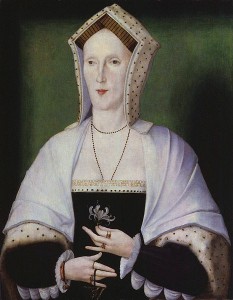 On the 27th May 1541, the elderly Margaret Pole, 8th Countess of Salisbury, godmother and former governess to Henry VIII’s daughter Mary, was executed at the Tower of London.
On the 27th May 1541, the elderly Margaret Pole, 8th Countess of Salisbury, godmother and former governess to Henry VIII’s daughter Mary, was executed at the Tower of London.
Eustace Chapuys, the imperial ambassador, recorded the Countess’s execution in a letter to the Queen of Hungary:
“About the same time, the very strange and lamentable execution of Mme. de Salisbury, the daughter of the duke of Clarence, and mother of Cardinal Pole, took place at the Tower in the presence of the Lord Mayor of London and about 150 persons more. At first, when the sentence of death was made known to her, she found the thing very strange, not knowing of what crime she was accused, nor how she had been sentenced; but at last, perceiving that there was no remedy, and that die she must, she went out of the dungeon where she was detained, and walked towards the midst of the space in front of the Tower, where there was no scaffold erected nor anything except a small block. Arrived there, after commending her soul to her Creator, she asked those present to pray for the King, the Queen, the Prince (Edward) and the Princess, to all of whom she wished to be particularly commended, and more especially to the latter, whose god-mother she had been. She sent her blessing to her, and begged also for hers. After which words she was told to make haste and place her neck on the block, which she did. But as the ordinary executor of justice was absent doing his work in the North, a wretched and blundering youth (garçonneau) was chosen, who literally hacked her head and shoulders to pieces in the most pitiful manner.”1
How awful!
You can read more about Margaret Pole, her life and last days, in my article The Execution of Margaret Pole, Countess of Salisbury.
Notes and Sources
- Calendar of State Papers, Spain, Volume 6 Part 1: 1538-1542, no. 166
Also on this day in history…
1537 – Chronicler Edward Hall records that “there was a Te Deum sung in St Paul’s cathedral for joy at the queen’s [Jane Seymour] quickening of her child”.